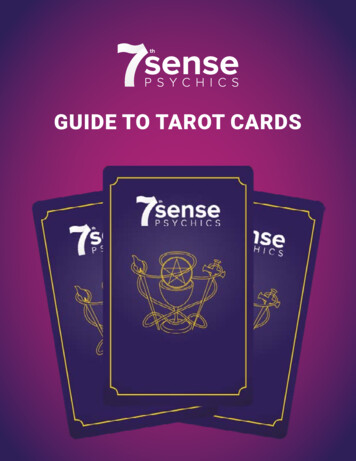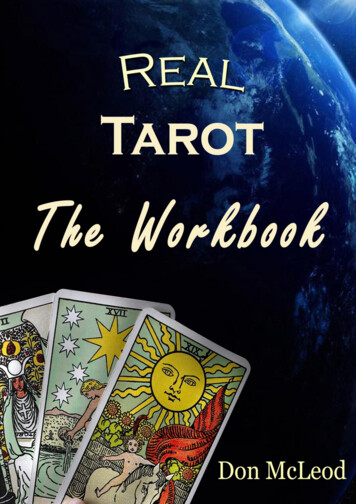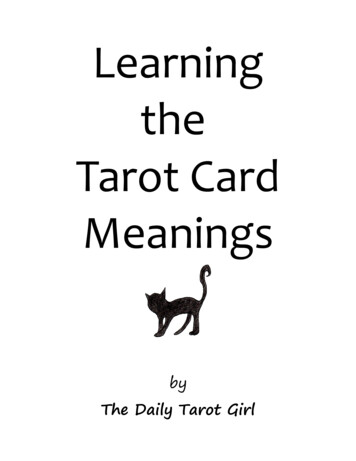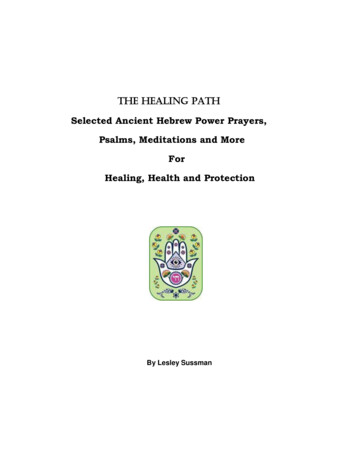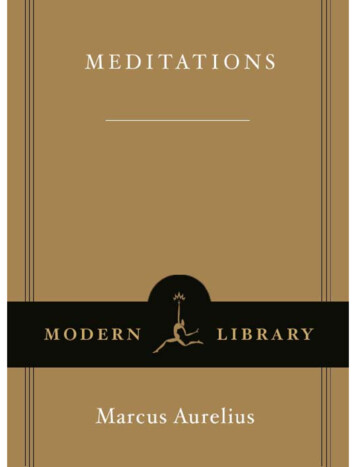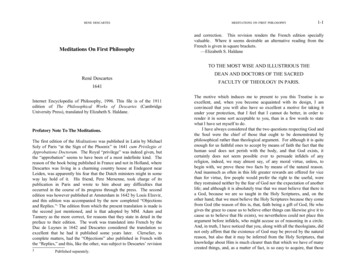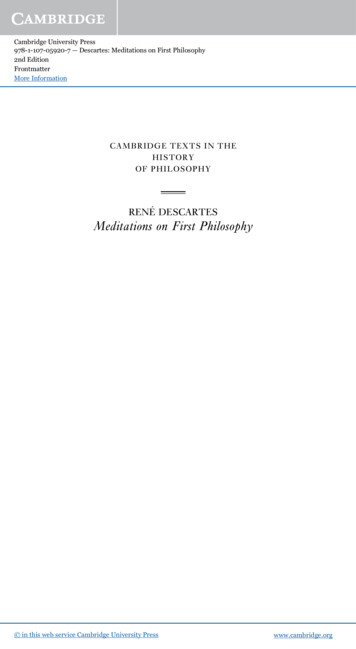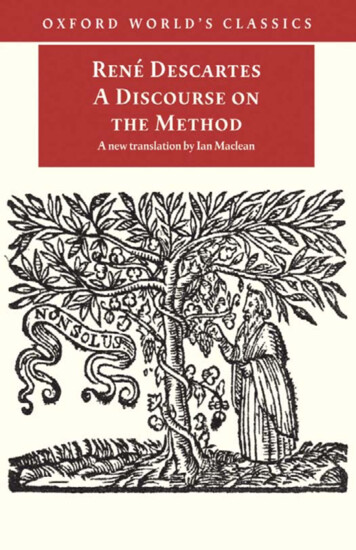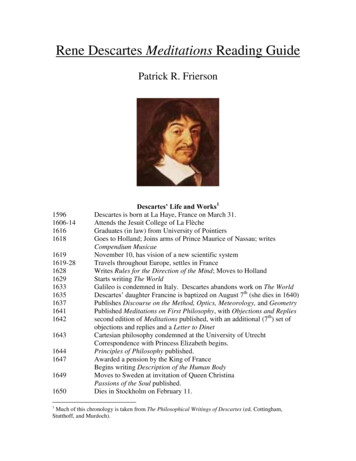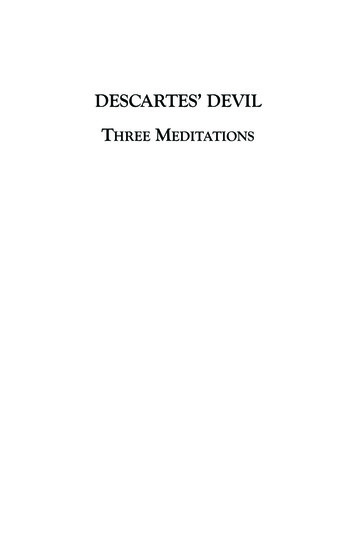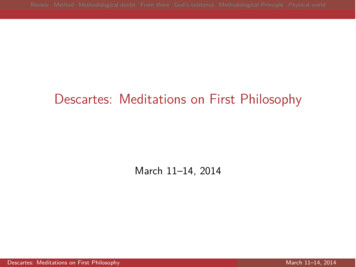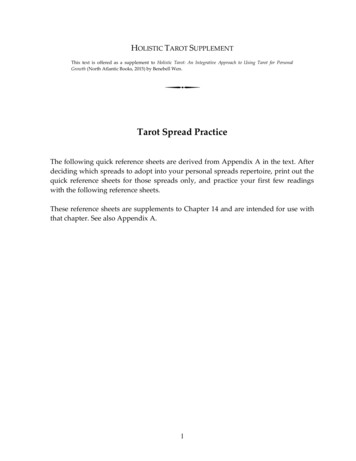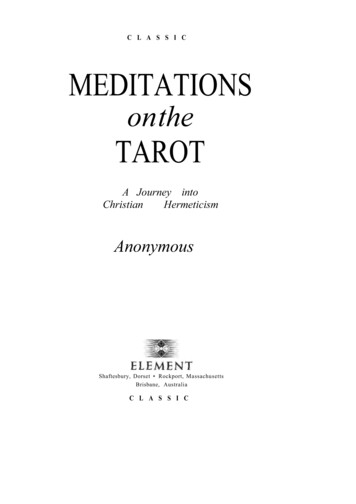
Transcription
C L A S S I CMEDITATIONSon theTAROTA Journey intoChristianHermeticismAnonymousShaftesbury, Dorset Rockport, MassachusettsBrisbane, AustraliaC L A S S I C
This project represents a work of LOVE.All texts so far gathered, as well as all future gatherings aim at exposinginterested students to occult information. Future releases will includesubmissions from users like YOU.For some of us, the time has come to mobilize. If you have an interest inassisting in this process - we all have strengths to bring to the table.email : occult.digital.mobilization@gmail.comComplacency serves the old gods.
This edition is dedicated toOur Lady of Chartres
CONTENTSLetter I: The Magician 3Letter II: The High Priestess 29Letter III: The Empress 53Letter IV: The Emperor 77Letter V: The Pope 99Letter VI: The Lover 123Letter VII: The Chariot 147Letter VIII: Justice 173Letter IX: The Hermit 199Letter X: The Wheel of Fortune 233Letter XI: Force 269Letter XII: The Hanged Man 305Letter XIII: Death 341Letter XIV: Temperance 373Letter XV: The Devil 401Letter XVI: The Tower of Destruction 431Letter XVII: The Star 463Letter XVIII: The Moon 493Letter XIX: The Sun 527Letter XX: The Judgement 555Letter XXI: The Fool 589Letter XXII: The World 625
ForewordThese meditations on the Major Arcana of the Tarot are Letters addressed tothe Unknown Friend. The addressee in this instance is anyone who will read allof them and who thereby acquires definite knowledge, through the experienceof meditative reading, about Christian Hermeticism. He will know also that theauthot of these Letters has said more about himself in these Letters than he wouldhave been able to in any other way. No matter what other source he might have,he will know the author better through the Letters themselves.These Letters are written in French because in France —since the eighteenthcentury until the present time, i.e. the second half of the twentieth c e n t u r y there exists a litetature on the Tarot, a phenomenon which is found nowhere else.On the other hand, there existed in France —and it still persists —a continuoustradition of Hermeticism, in which is united a spirit of free research with one ofrespect for the tradition. The purpose of these Letters therefore will be to "incarnate" into this tradition, i.e. to become an organic part of it, and in this way tocontribute support to it.As these Letters are intended only to serve, to sustain, and to support the Hermetic tradition — from its first appearance in the epoch of Hermes Trismegistus,lost in the remoteness of antiquity and become legendary—they are a definitemanifestation of this millennial-old current of thought, effort, and revelation.Their aim is not only to revive the tradition in the twentieth century but also,and above all, to immerse the reader (or rather the Unknown Friend) in thiscurrent —be it temporarily or for ever. For this reason the numerous citations ofancient and modern authors which you will find in these Letters are not due to
xiiMEDITATIONS ON THE TAROTliterary considerations, nor to a display of erudition. They are evocations of themasters of the tradition, in order that they may be present with their impulsesof aspiration and their light of thought in the current of meditative thought whichthese Letters on the twenty-two Major Arcana of the Tarot represent. For theseare in essence twenty-two spiritual exercises, by means of which you, dear UnknownFriend, will immerse yourself in the current of the living tradition, and thus enterinto the community of spirits who have served it and who are still serving it.And the citations in question only serve the aim of a "relief-setting" for thiscommunity. For the links in the chain of the tradition are not thoughts and efforts alone; they are above all living beings who were thinking these thoughts andwilling these efforts. The essence of the tradition is not a doctrine, but rather acommunity of spirits from age to age.There remains nothing more to say in this introduction to the Letter- Meditations on the Tarot, because all other questions concerning them will find a responsein the Letters themselves.Your friend greets you, dear Unknown Friend,from beyond the grave.
MEDITATIONS ON THE TAROT
Meditation on theFirst Major Arcanum of the TarotTHE MAGICIANLE BATELEUR
Spiritus ubi vult spiral: et vocemejus audis, sed nescis unde veniat,aut quo vadat: sic est omnis,qui natus est ex spiritu.(John iii, 8)The wind blows where it wills, andyou hear the sound of it, but you donot know whence it comes or whitherit goes; so it is with every onewho is born of the Spirit.(John iii, 8)Into this happy nightIn secret, seen of none.Nor saw I aught,Without other light or guide.Save that which in my heart did burn.(St. John of the Cross)*
LETTER ITHE MAGICIANDear Unknown Friend,The words of the Master cited above have served me the key for opening thedoor to comprehension of the first Major Arcanum of the Tarot, "The Magician",which is, in turn, the key to all the other Major Arcana. This is why I have putthem as an epigraph to this Letter. And then I have cited a verse from the "Songsof the Soul" of St. John of the Cross, because it has the virtue of awakening thedeeper layers of the soul, which one has to appeal to when the concern is the firstArcanum of the Tarot and, consequently, all the Major Arcana of the Tarot. For'Canciones del Alma, The Dark Night of the Soul, verse iii; Cisi. G. C. Graham. London, 1922, p. 29.
-1MEDITATIONS ON THE TAROTthe Major Arcana of the Tarot are authentic symbols, i.e. they are "magic, menial, psychic and moral operations"' awakening new notions, ideas, sentiments andaspirations, which means to say that they require an activity more profound thanthat of study and intellectual explanation. It is therefore in a state of deep contemplation—and always ever deeper—that they should be approached. And itis the deep and intimate layers of the soul which become active and bear fruitwhen one meditates on the Arcana of the Tarot. Therefore this "night", of whichSt. John of the Cross speaks, is necessary, where one withdraws oneself "in secret"and into which one has to immerse oneself each time that one meditates on theArcana of the Tarot. It is a work to be accomplished in solitude, and is all themore suitable for recluses.The Major Arcana of the Tarot are neither allegories nor secrets, because allegories are. in fact, only figurative represenrations of abstract notions, and secretsare only facts, procedures, practices, or whatever doctrines that one keeps to oneselffor a personal motive, since they are able to be understood and put into practiceby others to whom one does not want to reveal them. The Major Arcana of theTarot are authentic symbols. They conceal and reveal their sense at one and thesame time according to the depth of meditation. That which they reveal are notsecrets, i.e. things hidden by human will, but are arcana, which is something quitedifferent. An arcanum is that which it is necessary to "know" in order to be fruitful in a given domain of spiritual life. It is that which must be actively presentin our consciousness —or even in our subconscious —in order to render us capableof making discoveries, engendering new ideas, conceiving of new artistic subjects.In a word, it makes us fertile in our creative pursuits, in whatever domain of spirituallife. An arcanum is a "ferment" or an "enzyme" whose presence stimulates thespiritual and the psychic life of man. And it is symbols which are the bearers ofthese "ferments" or "enzymes" and which communicate them —if the mentalityand morality of the recipient is ready, i.e. if he is "poor in spirit" and does not,suffer from the most serious spiritual malady: self-complacency.Just as the arcanum is superior to the secret, so is the mystery superior to thearcanum. The mystery is more than a stimulating "ferment". It is a spiritual eventcomparable to physical birth or death. It is a change of the entire spiritual andpsychic motivation, or a complete change of the plane of consciousness. The sevensacraments of the Church are the prismatic colours of the white light of one soleMystery or Sacrament, known as that of the Second Birth, which the Master pointedout to Nicodemus in the nocturnal initiation conversation which He had withhim. It is this which Christian Hermeticism understands by the Great Initiation.It goes without saying that nobody initiates anyone else, it we understand by"initiation" the Mystery of the Second Birth or the Great Sacrament. This Initiation is operative from above and has the value and the duration of eterniry. TheInitiator is above, and here below one meets only the fellow pupils; and theyrecognise each other by the fact that they "love one another" (cf. John xiii. 34-35).
LETTER I THE MAGICIAN5There are no longer any more '"masters" because there is only one sole Master,who is the Initiator above. To be sure, there are always masters who teach theirdoctrines and also initiates who communicate some of the secrets which they possessto others who thus become in their turn the "initiates"— but all this has nothingto do with the Mystery of the Great Initiation.For this reason Christian Hermeticism, in so far as it is a human concern, initiates no one. Amongst Christian Hermeticists nobody assumes for himself the titleand the function of "initiator" or "master". For all are fellow pupils and each ismaster of each in some respect —just as each is a pupil of each in some other respect.We cannot do better than to follow the example of St. Anthony the Great, whosubjected himself in all sincerity to the pious men whom hevisited and made it his endeavour to learn for his own benefitjust how each was superior to him in zeal and ascetic practice.He observed the graciousness of one, the earnestness at prayerin another; studied the even temper of one and the kindheartedness of another; fixed his attention on the vigils kept by oneand on the studies pursued by another: admired one for his patient endurance, another for his fasting and sleeping on theground; watched closely this man's meekness and the forebearance shown by another; and in one and all alike he markedespecially devotion to Christ and the love they had for oneanother. Having thus taken his fill, he would return to his ownplace of asceticism. Then he assimilated in himself what he hadobtained from each and devoted all his energies to realizing inhimself the virtues of all. (St. Athanasius, The Life of SaintAnthony, ch. 4; trsl. R. T. Meyer, Westminster, 1950, p.21)It is the same conduct which must be applied by the Christian Hcrmeticist in thatwhich concerns knowledge and science —natural, historical, philological, philosophical, theological, symbolical and traditional. It amounts to learning the artof learning.Now, it is the Arcana which stimulate us and at the same time guide us in theart of learning. In this sense, the Major Arcana of the Tarot are a complete, entire, invaluable school of meditation, study, and spiritual effort — a masterly schoolin the art of learning.Dear Unknown Friend, Christian Hermeticism therefore has no pretension torival either religion or official science. He who is searching here for the "truereligion", the "true philosophy", or the "true science" is looking in the wrong direction. Christian Hermeticists are not masters, but servants. They do not have thepretension (that is, in any case, somewhat puerile) of elevating themselves abovethe holy faith of the faithful, or above the fruits of the admirable efforts of workersin science, or above the creations of artistic genius. Hermeticists are not guardingthe secret of future discoveries in the sciences. They do not know, for example.
6MEDITATIONS ON THE TAROTjust as everyone at present is ignorant of it, the effective remedy against cancer.Moreover they would be monsters if they were to guard the secret of the remedyagainst this bane of humanity without communicating it. No. they do not knowit, and they will be the first to recognise the superiority of the future benefactorof the human race, that savant who will discover this remedy.Likewise they recognise without reserve the superiority of a Francis of Assisi —and of many others —who was a man of the so-called "exoteric" faith. They knowalso that each sincere believer is potentially a Francis of Assisi. Men and womenof faith, of science and of art are their superiors in many essential points. Hermeticists know it well and do not flatter themselves to be better, to believe better, to know better or to be more competent. They do not secretly guard a religion,which to them is appropriate, to replace the existing religions, or a science to replacethe current sciences, or arts to replace the fine arts of today or yesterday. That whichthey possess does not comprise any tangible advantage or objective superioritywith regard to religion, science and art; what they possess is only the communalsoul of religion, science and art. What is this mission of conserving the communalsoul of religion, science and art? I am going to reply with a concrete example,as follows:You know without doubt, dear Unknown Friend, that many —and several ofthem are writers —in France, Germany, England, and elsewhere, promulgate thedoctrine of the so-called "two churches": the church of Peter and the church ofJohn, or of "two epochs"—the epoch of Peter and the epoch of John. You knowalso that this doctrine teaches the end —more or less at hand —of the church ofPeter, or above all of the papacy which is its visible symbol, and that the spiritofjohn. the disciple loved by the Master, he who leaned on his breast and heardthe beating of his heart, will replace it. In this way it teaches that the "exoteric"church of Peter will make way for the "esoteric" church ofjohn, which will bethat of perfect freedom.Now, John, who submitted himself voluntarily to Peter as leader or prince ofthe apostles, did not becom
Save that which in my heart did burn. (St. John of the Cross)* LETTER I THE MAGICIAN Dear Unknown Friend, The words of the Master cited above have served me the key for opening the door to comprehension of the first Major Arcanum of the Tarot, "The Magician", which is, in turn, the key to all the other Major Arcana. This is why I have put them as an epigraph to this Letter. And then I have .
